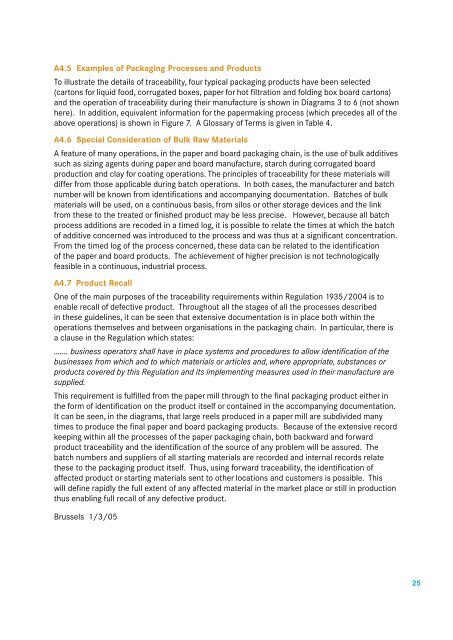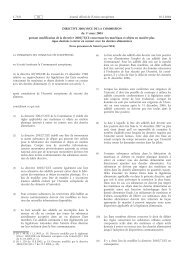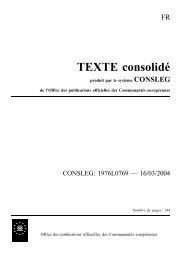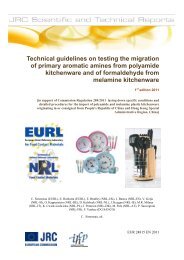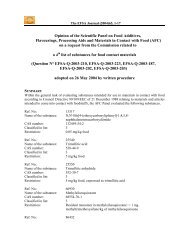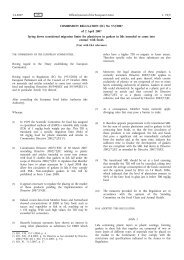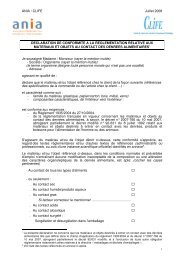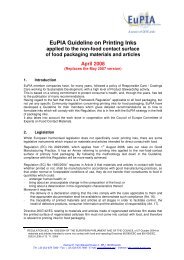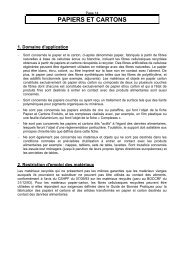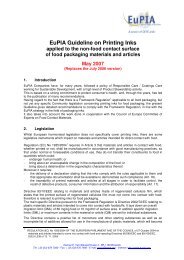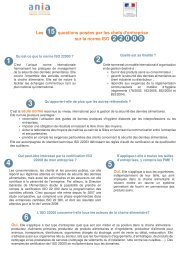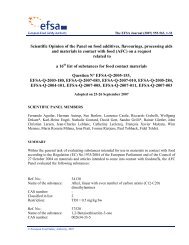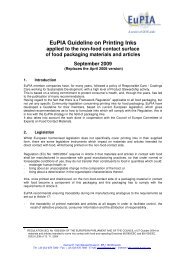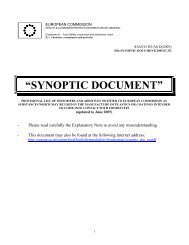Good Manufacturing Practice for the Manufacture of Paper - CEPI ...
Good Manufacturing Practice for the Manufacture of Paper - CEPI ...
Good Manufacturing Practice for the Manufacture of Paper - CEPI ...
You also want an ePaper? Increase the reach of your titles
YUMPU automatically turns print PDFs into web optimized ePapers that Google loves.
A4.5 Examples <strong>of</strong> Packaging Processes and Products<br />
To illustrate <strong>the</strong> details <strong>of</strong> traceability, four typical packaging products have been selected<br />
(cartons <strong>for</strong> liquid food, corrugated boxes, paper <strong>for</strong> hot filtration and folding box board cartons)<br />
and <strong>the</strong> operation <strong>of</strong> traceability during <strong>the</strong>ir manufacture is shown in Diagrams 3 to 6 (not shown<br />
here). In addition, equivalent in<strong>for</strong>mation <strong>for</strong> <strong>the</strong> papermaking process (which precedes all <strong>of</strong> <strong>the</strong><br />
above operations) is shown in Figure 7. A Glossary <strong>of</strong> Terms is given in Table 4.<br />
A4.6 Special Consideration <strong>of</strong> Bulk Raw Materials<br />
A feature <strong>of</strong> many operations, in <strong>the</strong> paper and board packaging chain, is <strong>the</strong> use <strong>of</strong> bulk additives<br />
such as sizing agents during paper and board manufacture, starch during corrugated board<br />
production and clay <strong>for</strong> coating operations. The principles <strong>of</strong> traceability <strong>for</strong> <strong>the</strong>se materials will<br />
differ from those applicable during batch operations. In both cases, <strong>the</strong> manufacturer and batch<br />
number will be known from identifications and accompanying documentation. Batches <strong>of</strong> bulk<br />
materials will be used, on a continuous basis, from silos or o<strong>the</strong>r storage devices and <strong>the</strong> link<br />
from <strong>the</strong>se to <strong>the</strong> treated or finished product may be less precise. However, because all batch<br />
process additions are recoded in a timed log, it is possible to relate <strong>the</strong> times at which <strong>the</strong> batch<br />
<strong>of</strong> additive concerned was introduced to <strong>the</strong> process and was thus at a significant concentration.<br />
From <strong>the</strong> timed log <strong>of</strong> <strong>the</strong> process concerned, <strong>the</strong>se data can be related to <strong>the</strong> identification<br />
<strong>of</strong> <strong>the</strong> paper and board products. The achievement <strong>of</strong> higher precision is not technologically<br />
feasible in a continuous, industrial process.<br />
A4.7 Product Recall<br />
One <strong>of</strong> <strong>the</strong> main purposes <strong>of</strong> <strong>the</strong> traceability requirements within Regulation 1935/2004 is to<br />
enable recall <strong>of</strong> defective product. Throughout all <strong>the</strong> stages <strong>of</strong> all <strong>the</strong> processes described<br />
in <strong>the</strong>se guidelines, it can be seen that extensive documentation is in place both within <strong>the</strong><br />
operations <strong>the</strong>mselves and between organisations in <strong>the</strong> packaging chain. In particular, <strong>the</strong>re is<br />
a clause in <strong>the</strong> Regulation which states:<br />
....... business operators shall have in place systems and procedures to allow identification <strong>of</strong> <strong>the</strong><br />
businesses from which and to which materials or articles and, where appropriate, substances or<br />
products covered by this Regulation and its implementing measures used in <strong>the</strong>ir manufacture are<br />
supplied.<br />
This requirement is fulfilled from <strong>the</strong> paper mill through to <strong>the</strong> final packaging product ei<strong>the</strong>r in<br />
<strong>the</strong> <strong>for</strong>m <strong>of</strong> identification on <strong>the</strong> product itself or contained in <strong>the</strong> accompanying documentation.<br />
It can be seen, in <strong>the</strong> diagrams, that large reels produced in a paper mill are subdivided many<br />
times to produce <strong>the</strong> final paper and board packaging products. Because <strong>of</strong> <strong>the</strong> extensive record<br />
keeping within all <strong>the</strong> processes <strong>of</strong> <strong>the</strong> paper packaging chain, both backward and <strong>for</strong>ward<br />
product traceability and <strong>the</strong> identification <strong>of</strong> <strong>the</strong> source <strong>of</strong> any problem will be assured. The<br />
batch numbers and suppliers <strong>of</strong> all starting materials are recorded and internal records relate<br />
<strong>the</strong>se to <strong>the</strong> packaging product itself. Thus, using <strong>for</strong>ward traceability, <strong>the</strong> identification <strong>of</strong><br />
affected product or starting materials sent to o<strong>the</strong>r locations and customers is possible. This<br />
will define rapidly <strong>the</strong> full extent <strong>of</strong> any affected material in <strong>the</strong> market place or still in production<br />
thus enabling full recall <strong>of</strong> any defective product.<br />
Brussels 1/3/05<br />
25


